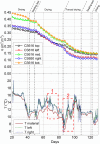A Procedure to Measure the in-Situ Hygrothermal Behavior of Earth Walls
- PMID: 28788603
- PMCID: PMC5453368
- DOI: 10.3390/ma7043002
A Procedure to Measure the in-Situ Hygrothermal Behavior of Earth Walls
Abstract
Rammed earth is a sustainable material with low embodied energy. However, its development as a building material requires a better evaluation of its moisture-thermal buffering abilities and its mechanical behavior. Both of these properties are known to strongly depend on the amount of water contained in wall pores and its evolution. Thus the aim of this paper is to present a procedure to measure this key parameter in rammed earth or cob walls by using two types of probes operating on the Time Domain Reflectometry (TDR) principle. A calibration procedure for the probes requiring solely four parameters is described. This calibration procedure is then used to monitor the hygrothermal behavior of a rammed earth wall (1.5 m × 1 m × 0.5 m), instrumented by six probes during its manufacture, and submitted to insulated, natural convection and forced convection conditions. These measurements underline the robustness of the calibration procedure over a large range of water content, even if the wall is submitted to quite important temperature variations. They also emphasize the importance of gravity on water content heterogeneity when the saturation is high, as well as the role of liquid-to-vapor phase change on the thermal behavior.
Keywords: cob; dielectric constant; full scale experiments; hygrothermal behavior; rammed earth; water content measurement.
Conflict of interest statement
The authors declare no conflict of interest
Figures








References
-
- Williams C., Goodhew S., Watson L. The feasibility of earth block masonry for building sustainable walling in the United Kingdom. J. Build. Apprais. 2010;6:99–108.
-
- Peuportier B., Thiers S., Guiavarch A. Eco-design of buildings using thermal simulation and life cycle assessment. J. Clean. Prod. 2013;39:73–78.
-
- Harris D.J. A quantitative approach to the assessment of the environmental impact of building materials. Build. Environ. 1999;34:751–758.
-
- Morel J.C., Mesbah A., Oggero M., Walker P. Building houses with local materials: means to drastically reduce the environmental impact of construction. Build. Environ. 2001;36:1119–1126.
-
- Habert G., Castillo E., Vincens E., Morel J.C. Power: A new paradigm for energy use in sustainable construction. Ecol. Indic. 2012;23:109–115.
LinkOut - more resources
Full Text Sources
Other Literature Sources

